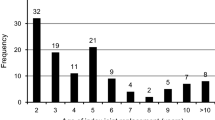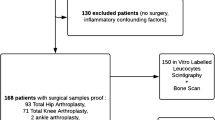Abstract
In recent years, with the higher median life expectancy, the number of hip and knee replacements has increased. Clinical examination and morphological studies are essential to evaluate patients with a painful arthroplasty. Nuclear medicine examinations also play an important role, their main usefulness being the exclusion of prosthesis complications. Nevertheless, conventional examinations, namely bone scan and white blood cell scintigraphy, can also identify complications, such as loosening and infection. This study describes the normal and pathologic patterns of a bone scan and exemplifies ten common situations that can cause pain in patients with hip or knee arthroplasty, other than loosening and infection, which can be disclosed on a bone scintigraphy. The ten situations that should be considered and looked for when analysing a bone scan are: referred pain, patellofemoral pain syndrome, fractures, fissures, abscess/haematoma, bone insert behaviour, heterotopic ossification, greater trochanter pseudarthrosis, osteoarthritis extension in a knee with an unicompartmental prosthesis, and systemic disease with bone involvement.









Similar content being viewed by others
References
Love C, Marwin SE, Palestro CJ (2009) Nuclear Medicine and the infected joint replacement. Semin Nucl Med. doi:10.1053/j.semnuclmed.2008.08.007
Palestro CJ (2014) Nuclear medicine and the failed joint replacement: past, present, and future. World J Radiol. doi:10.4329/wjr.v6.i7.446
Palestro CJ, Love C, Marwin SE (2006) Nuclear medicine of the painful joint replacement. Appl Radiol. http://appliedradiology.com/articles/nuclear-medicine-of-the-painful-joint-replacement
OECD European Union (2014) Hip and knee replacement, health at a glance: Europe 2014. OECD Publishing, Paris. doi:10.1787/health_glance_eur-2014-34-en
Adesanya O, Sprowson A, Masters J, Hutchinson C (2015) Review of the role of dynamic 18F-NaF PET in diagnosing and distinguishing between septic and aseptic loosening in hip prosthesis. J Orthop Surg Res. doi:10.1186/s13018-014-0147-7
Jansen A, Smit F, Arias-Bouda LMP (2012) The role of Nuclear Medicine techniques in differentiation between septic and aseptic loosening of total hip and knee arthroplasty. JTijdschr Nucl Geneesk 34(4):988–994
Ouyang Z, Li H, Liu X, Zhai Z, Li X (2014) Prosthesis infection: diagnosis after total joint arthroplasty with three-phase bone scintigraphy. Ann Nucl Med. doi:10.1007/s12149-014-0899-5
Vries EFJ, Roca M, Jamar F, Israel O, Signore A (2010) Guidelines for the labelling of leucocytes with 99 mTc-HMPAO. Eur J Nucl Med Mol Imaging. doi:10.1007/s00259-010-1394-4
Erba PA, Israel O (2014) SPECT/CT in infection and inflammation. Clin Transl Imaging. doi:10.1007/s40336-014-0092-9
Kwee TC, Kwee RM, Alavi A (2008) FDG-PET for diagnosing prosthetic joint infection: systematic review and metaanalysis. Eur J Nucl Med Mol Imaging. doi:10.1007/s00259-008-0887-x
Zoccali C, Teori G, Salducca N (2009) The role of FDG-PET in distinguishing between septic and aseptic loosening in hip prosthesis: a review of literature. Int Orthop. doi:10.1007/s00264-008-0575-2
Reinartz P, Mumme T, Hermanns B, Cremerius U, Wirtz DC, Schaefer WM et al (2005) Radionuclide imaging of the painful hip arthroplasty: positron-emission tomography versus triple-phase bone scanning. J Bone Joint Surg Br. doi:10.1302/0301-620X.87B4.14954
Reinartz P (2009) FDG-PET in patients with painful hip and knee arthroplasty: technical breakthrough or just more of the same. Q J Nucl Med Mol Imaging 53(1):41–50
Kobayashi N, Inaba Y, Choe H, Ike H, Fujimaki H, Tezuka T et al (2011) Use of F-18 fluoride PET to differentiate septic from aseptic loosening in total hip arthroplasty patients. Clin Nucl Med. doi:10.1097/RLU.0b013e3182291ae7
Saha S, Burke C, Desai A, Vijayanathan S, Gnanasegaran G (2013) SPECT-CT: applications in musculoskeletal radiology. Br J Radiol. doi:10.1259/bjr.20120519
Girma A, Paycha F (2013) Place de la scintigraphie osseuse planaire et TEMP/TDM dans l’exploration des prothèses de hanche douloureuses. Méd Nucl. doi:10.1016/j.mednuc.2013.07.003
Girma A, Paycha F, Nizard R (2013) Rôle de la scintigraphie osseuse dans l’exploration des prothèses de genou douloureuses. In: Presented at the 69th Réunion Scientifique de l’ACOMEN « Prothèses orthopédiques et Médecine Nucléaire »
Cyteval C, Bourdon A (2012) Imaging orthopedic implant infections. Diagn Interv Imaging. doi:10.1016/j.diii.2012.03.004
Jacobson JA, Morag (2015) Hip replacement imaging. Medscape website. http://emedicine.medscape.com/article/398669-overview. Updated oct 27
Roth TD, Maertz NA, Parr JA, Buckwalter KA, Choplin RH (2012) CT of the hip prosthesis: appearance of components, fixation, and complications. RadioGraphics. doi:10.1148/rg.324115183
Cyteval C, Hamm V, Sarrabère MP, Lopez FM, Maury P, Taourel P (2002) Painful Infection at the site of hip prosthesis: CT imaging. Radiology. doi:10.1148/radiol.2242010989
DeLee JG, Charnley J (1976) Radiological demarcation of cemented sockets in total hip replacement. Clin Orthop 121:20–32
Gruen TA, McNeice GM, Amstutz HC (1979) "Modes of failure" of cemented stem-type femoral components: a radiographic analysis of loosening. Clin Orthop 141:17–27
Draper CE, Fredericson M, Gold GE, Besier TF, Delp SL, Beaupre GS, Quon A (2012) Patients with patellofemoral pain exhibit elevated bone metabolic activity at the patellofemoral joint. J Orthop Res. doi:10.1002/jor.21523
Fontaine C, Vannineuse A (2005) Fractures du genou. Springer, Paris, pp 317–330. http://eknygos.lsmuni.lt/springer/165/317-330.pdf
Tabouret-Viauda C, Maintaa I, Boudabbous S, Amzalaga G, Ratiba O, Ragera O, Paycha F (2014) High protracted 99mTc-HDP uptake in synthetic bone implants—a potentially misleading incidental finding on bone scintigraphy. Knee. doi:10.1016/j.knee.2014.08.005
Shehab D, Elgazzar AH, Collier BD (2002) Heterotopic ossification. J Nucl Med 43(3):346–353
Brooker AF, Bowerman JW, Robinson RA, Riley LH Jr (1973) Ectopic ossification following total hip replacement. Incidence and a method of classification. J Bone Joint Surg Am 55(8):1629–1632
Capello WN, Feinberg JR (2008) Trochanteric excision following persistent nonunion of the greater trochanter. Orthopedics 31(7):711
Salai M, Zippel D, Perelman M, Chechik A (1999) Revision hip arthroplasty in patients with a history of previous malignancy. J Surg Oncol 70:122–125
Schmidt AH, Walker G, Kyle RF, Thompson RC (1996) Periprosthetic metastatic carcinoma: pitfalls in the management of two cases initially diagnosed as osteolysis. J Arthroplasty 11(5):613–619
Author information
Authors and Affiliations
Corresponding author
Ethics declarations
Conflict of interest
The authors have nothing to disclose.
Rights and permissions
About this article
Cite this article
Vaz, S., Ferreira, T.C., Salgado, L. et al. Bone scan usefulness in patients with painful hip or knee prosthesis: 10 situations that can cause pain, other than loosening and infection. Eur J Orthop Surg Traumatol 27, 147–156 (2017). https://doi.org/10.1007/s00590-016-1884-6
Received:
Accepted:
Published:
Issue Date:
DOI: https://doi.org/10.1007/s00590-016-1884-6




